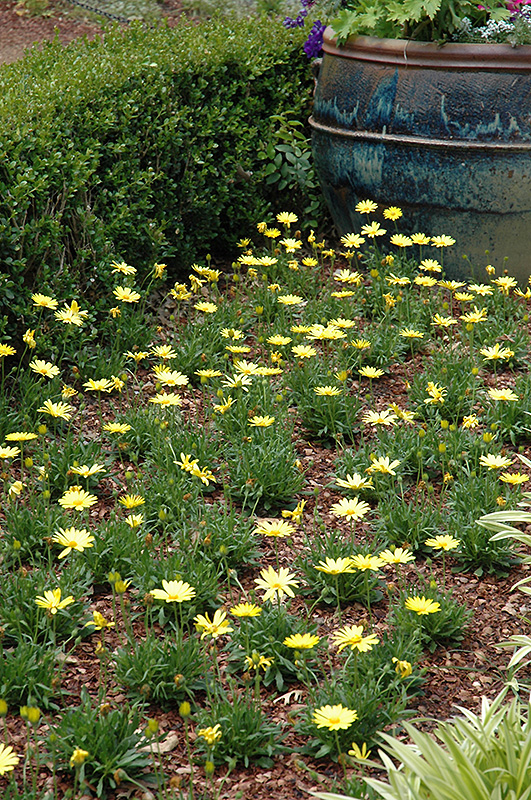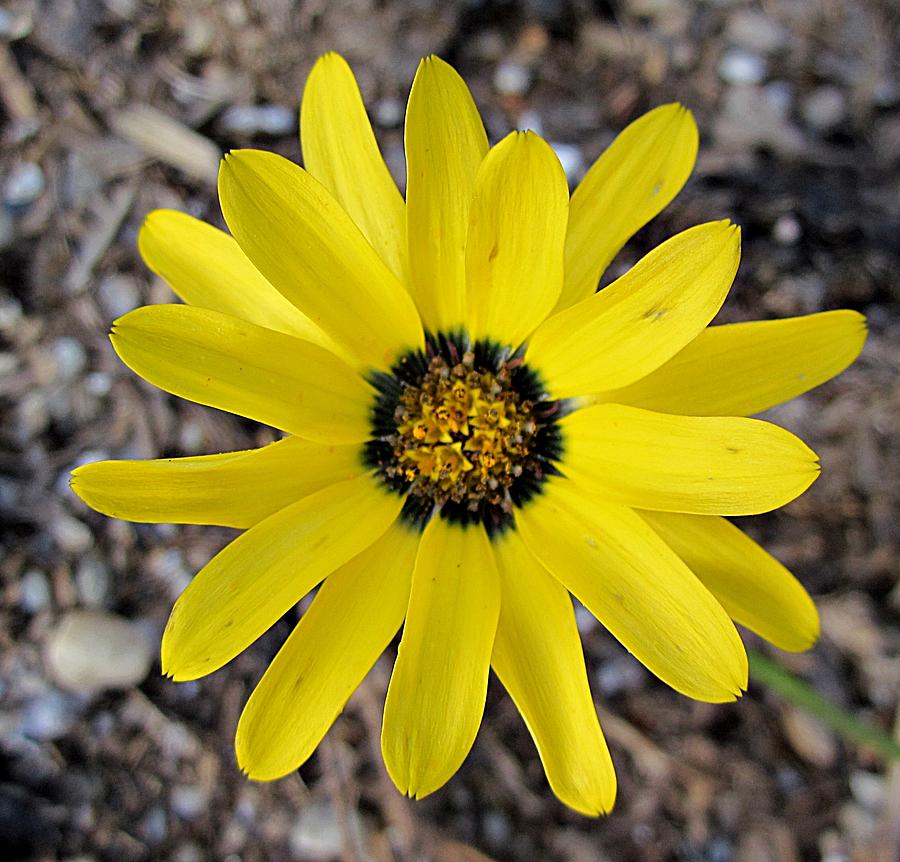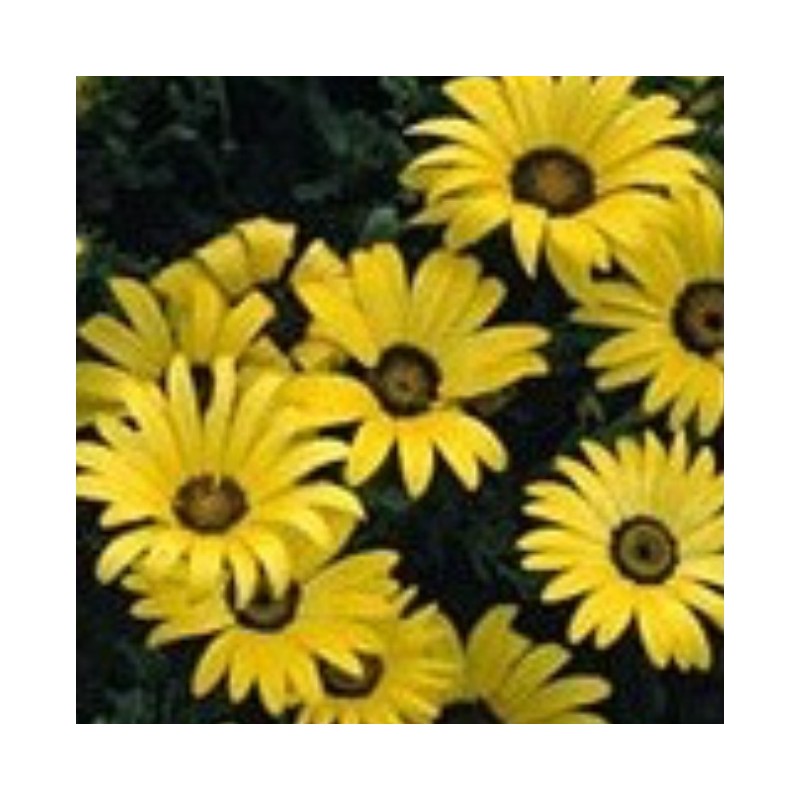The term daisy can refer to several species of flowering plants, both annual and perennial. The annual African Daisy (Osteospermum sp.) is a frost-tender perennial member of the Asteraceae family that is typically grown as an annual. Native to South Africa, the plants are named osteo- spermum- .
Start indoors 8-10 weeks before last frost date and transplant out after all chance of frost has passed. Surface sow seeds and cover with a thin layer (1/16 inch) of fine seed starting mix. Keep plants well watered until they reach 4 inches tall, after which you can cut down on irrigation, as the plants will flop over when over watered. Plants prefer full sun; they can handle drying out and are considered moderately drought tolerant. They handle a wide range of soils as long as the soil is well drained.
Keep plants deadheaded to encourage a longer blooming season. Plants dislike excessive humidity, so be mindful of air circulation. An excellent choice for container growing and bedding, daisies make a statement planted en masse.
Another type of African Daisy is Latin name Dimorphotheca sinuata, a drought-tolerant flower whose blooms follow the sun and open and close with the day and night. The Chocolate Daisy is a clumping perennial native wildflower. Native to the dry and rocky Southwest, it is hardy from USDA zones 4-9. The plants can grow in just about any soil conditions as long as they have access to full sun. Direct sow seeds outdoors after chance of frost has passed. Keep seeds moist until germinated and plants regularly watered until established.
African Daisy will produce beautiful 2.5cm flowers, atop attractive green foliage. They mature to a height of roughly 20 to 35cm tall, displaying their blooms in shades of orange, yellow, salmon & white. African daisy is a very drought tolerant plant, which doesn't require much maintenance once established.
They are known to attract an array of bees to the garden. They will produce many seeds at the end of the season, which will allow you to regrow the plants the following year. You may also let the seeds fall to the bare ground beneath to re-establish new plants the following Spring. African Daisy plants can be grown in the garden, in flower beds, along borders and in pots & containers as well. Their low growth habit makes them perfect in raised beds as well, and they can be added with other drought tolerant plant life as well.
African daisies, also known as cape marigold, are annual flowering plants native to the arid regions of southern Africa. They are grown most commonly as ornamental garden plants and produce numerous showy, colorful blooms in early summer through fall. The large flowers close at night and during bad weather but shine in full sun. Flower colors include white, yellow, orange, red, pink and violet. The African daisy is very easy to grow and requires very little maintenance after planting. Grow a garden filled with African Daisy flowers, from freshly harvested Dimorphotheca sinuata flower seeds.
African Daisy will produce gorgeous, 1 inch flowers, atop attractive green foliage. They mature to a height of roughly 8 to 16 inches tall, displaying their blooms in shades of orange, yellow, salmon & white. They are known to attract an array of bees to the garden, such as honeybees & bumblebees. The African Daisy is native to South Africa and it is often referred to as a Cape Marigold. Originating from the South African region has led this flower to flourish when planted in full sun. However, it does not like hot weather that is accompanied by humidity.
The higher level of humidity the African Daisy is exposed to, the more copious its foliage will be and the fewer flowers will bloom. The only humidity it will tolerate comes in combination with cooler climates. The African Daisy prefers hot, dry weather similar to where it originated. This flower is highly drought tolerant, but needs well-drained soil.
It can be started indoors and deadheading it will often prolong blooming. The blooms on the flower will close when they are beneath a shaded area and after dusk. The African Daisy is a good winter annual when planted in zones and a good spring/summer annual when planting is done in zones 8-10. This plant will not survive frost and may only reseed itself if the seed drops on bare ground. A unique fact about African Daisy is it produces 2 different seeds and both types of seed generate the same plant and spread the diversity of its colors. A native of South Africa, it has naturalized throughout the southwestern United States.
Blooms are 2-4 inches across in brilliant shades of white, yellow, and orange. An excellent variety to sow in early spring, as it will produce extravagant color for weeks. Sow in early spring after the danger of frost has passed, seedlings are not winter hardy. You will be delighted with this outstanding performer.
Angelonia is also called summer snapdragon, and once you get a good look at it, you'll know why. It has flower spires that reach a foot or two high, but they're studded with fascinating snapdragon-like flowers with beautiful colorations in purple, white, or pink. It's the perfect plant for adding bright color to hot, sunny spaces, where it will bloom all summer long.
While all varieties are beautiful, keep an eye out for the sweetly scented selections. While most gardeners treat angelonia as an annual, it is perennial in Zones 9-10. Or, if you have a bright, sunny spot indoors, you can keep it flowering all winter. Osteospermum 'Voltage Yellow' is a bushy, evergreen, tender perennial with a profusion of bright golden-yellow daisy flowers adorned with darker centers. In cool summer climates, these beautiful flowers will produce a long-lasting display from spring to frost. The blossoms are borne on upright stems clad with lanceolate green leaves.
Great for sunny borders and containers where the luminous blooms will bring a pleasing pop of color. Sow in early spring, seedlings are not winter hardy. African Daisy - African Daisy is also known as the Cape Marigold. It is easily grown from flower seeds, and it is one of the most colorful flowers for a beautiful garden.
The plant is excellent for naturalized areas and as ground cover for large areas, for parking strips, borders, large pots and tubs. The flowers are 1-1/2 inch wide flowers, which close at night, in the shade, and during cloud cover. The flower colors are available in shades of white, orange, yellow and salmon. The African daisy plant is exceptional for hot, sun-drenched landscapes. Sow seeds directly outdoors in early spring after frost season is completely over. In mild, winter-rainfall areas they may be sown in late autumn or early winter (April–May).
They can be sown directly in prepared beds, on a calm day when the wind will not blow the papery seeds away. For best results, prepare the beds with compost and remove clods and stones to make a fine bed. Sow thickly and rake lightly to cover the seeds to prevent them being blown or washed away. Seedlings can be thinned or pricked out when they are about 5 cm tall.
Young plants must also be kept moist until they reach the height of about 10 cm. Seed is widely available in nurseries and supermarkets in South Africa. Selected forms of Namaqualand daisies are available for cultivation in a variety of shades, such as orange, cream, yellow and salmon. They add perk and smile to any sunny garden location. The flowers produce and drop seeds that allow for new growth the following year in some warmer regions. Department of Agriculture Hardiness Zones 8 through 11.
This easy-going plant is drought tolerant, and it can even take a bit of frost. African Daisy is great for roadsides, floral gardens, arid regions, mixtures, open fields and rock gardens. Dimorphotheca Sinuata seeds germinate quickly, and African Daisy likes full sun and hot, dry weather that is similar to its natural habitat. Cape Marigold is very drought tolerant, and this plant can tolerate some cool humid climate. African Daisy can be a good winter annual to plant in zones and a good spring/summer annual in zones 8-10.
Cape Marigold dies at frost, but it re-seeds itself if the seed falls on bare ground and will re-grow following spring. In its native South Africa, the African daisy bursts into bloom when the spring rains come, although in gardens plants bloom copiously all summer. A tender perennial, it is grown most commonly as an annual. Like many of the plants in the daisy family from South Africa, it's tough enough to live in hot, dry conditions, but a modicum of moisture will bring out stellar blooms. On dull days and at night, arctotis closes its flowers.
Daisy-like flowers 2 inches across, come in single, bi- or multicolors in shades of white, yellow, orange, red, coral, pink, blue, lavender, and purple. Oval or lance-shaped leaves are green or gray-green with smooth or toothed margins. Flowers close at night or on dark overcast days, though there are newer cultivars that remain open. African Marigold petals are edible with a slightly bitter, citrusy/spice flavor. They make a pretty garnish on rice, salads, or desserts.
The prolific display starts in the mild temperatures of spring in any climate and often continues to frost. In frost-free climates, sow in fall and enjoy their sunny presence from winter through spring. Flowers best during mild temperatures; a great choice for the spring garden. African Daisy Mix Dimorphotheca Sinuata is an annual that comes from South Africa, and the plant has been naturalized throughout the United States.
Commonly called Cape Marigold this flowering annual produces large blooms in brilliant shades of white, yellow, and orange. African Daisy is very easy to grow from seeds, and this excellent variety will produce extravagant colors for weeks. Are you thinking about adding daisies to your garden this spring? If so, you're in luck as daisies are some of the easiest flowers to grow.
Commonly grown from seeds, daisies can be planted directly into your flowerbeds. Besides ample sunlight and a well-draining soil, daisies don't need much to thrive, making them one of the best low-maintenance flowers. Daisies love the sun, making them one of the best full-sun flowers and aren't usually bothered by insects or disease.
For best results, plant yours in a nutrient-rich, well-draining soil with seeds about 9 to 12 inches apart. Most Osteospermum available are hybridised to better suit our conditions, as such some might be infertile and will not grow from saved seed. The best bet is to take advice regarding which cultivar will be best for your garden. As mentioned, plant Osteospermum in well-drained soil as soon as spring brings favourable conditions. Osteospermum are fairly hardy but will require initial care to ensure the soil remains moist.
With seed, simply press into the soil and monitor throughout the germination period. With cultivars, dig a planting hole and allow 2.5-5cm of the stems to lie below the surface. After this is done, fill in the hole with a mix of excavated soil and organic matter and water in well. African Daisy - African Daisy tolerates a wide range of soil types and occupies areas with 500 to 1500 mm annual rainfall. Like all South African wild flowers, this beauty is best grown in well-draining soil, not heavy loam or clay.
If conditions are right, the African Daisy plant can provide spectacularly colorful blooms, and it is easily established from wild flower seed. Common daisies , Shasta daisies (Leucanthemum × superbum) and even the ox-eye daisy are easy-growing flowers that add a touch of whimsy to the garden. Although you can get new plants from old ones by dividing them in the fall, harvesting daisy seeds allows you to share them with others or to plant at a later date. Department of Agriculture plant hardiness zones 3 or 4 through 9 or 10, depending on species. Daisy-like flowers burst from the plant every morning. The blooms all consist of a ring of showy outer petals in bright colors and a compact "eye" in the center.
The eye of the bloom can be several different colors, typically brown, gold, pink, or green. While the majority of the flowers come in solid colors, some fade into another color toward the center of the bloom for an almost tie-dye effect. With so many colors to choose from, there's no reason not to try out an African daisy.
Your Creeping Daisy seeds will begin to show signs of life within as little as 7 to 10 days, but can take up to 2 weeks to germinate. The plants themselves will reach a mature height of 6 to 12 inches tall, producing pure white petaled blooms, which are accented with a golden-yellow center. The plants can be spaced 8 to 12 inches apart from one another. Creeping Daisy is often used as a groundcover and goes great in flower beds, borders, pots & containers or in a naturalized setting.
They will also attract an array of beneficial insects to the garden, such as butterflies, bumblebees, honeybees, hummingbirds & ladybugs as well. You may also let the seeds fall to the bare ground beneath to reestablish new plants the following Spring. Expect your African daisy to grow to between 1 and 2 feet tall. To encourage your plant to bloom from late spring well into the fall, cut the flowers and use them in a vase. Deadhead those that you don't snip off to enjoy indoors. These easy to grow winter annuals are sown directly into garden beds in full sun in autumn, when the daytime temperatures are between 18 to 22°C.
Bought one of these over Memorial Day weekend 2017, when 1 flower was in early bloom stage. 1 week later and now there are 5 fully blooming, ultra yellow daisies and 3 more buds on deck. The color is an intense true yellow, almost identical to the Carpet Gold Bidens offered by PW. Flowers fold the tent at dusk but report for duty next morning, sunny or not.





























No comments:
Post a Comment
Note: Only a member of this blog may post a comment.